6.3 PLANTS
Algae
/ Aquatic
Macrophyte / Riparian
floodplain, vegetation and swamps /
Mangroves
Algae--
Adopting a category for purposes of convenience, all algae (including
cyanobacteria) are treated as plants. This is despite the fact that many
of the smaller single-celled species are small enough to be considered
microorganisms. Some of these single-celled forms may associate to form
chains or colonies. As plants, algae live by photosynthesis using the
energy of sunlight to convert carbon dioxide to starch. Because they need
adequate light they are sensitive to the clarity and depth of the water.
Periphyton
Algae grow attached to all kinds of solid objects. They can form thin
crusts or 'meadows' several millimeters thick, and even occur as thin
films coating sand grains. Larger cells form a surface on which smaller
ones may attach, and the layers of attached algae may be mixed with bacteria,
fungi, protozoa and the breakdown products of dying cells. All such layers
of attached organisms are referred to as periphyton (this term is usually
used when the layer consists mainly of algae) or biofilm. It is the main,
sometimes the only, source of plant food in stony rivers and shallow waters
where macrophytes (mainly flowering plants; see Section 'Aquatic Macrophytes')
are absent and shade or turbidity do not limit light availability. Periphyton
is thus is an important food source for many kinds of animals.
Diatoms (Bacillariophyta) are a species rich and sometimes dominant component
of the periphyton, especially in shaded upland rivers, but some forms
are planktonic. Their single cells are composed of two valves, called
frustules, composed of silica (essentially, glass). The frustules vary
in shape and are etched by distinctive patterns or striations that can
be used as characteristics to aid their identification when examined at
high magnification. Diatoms are generally characteristic of clean waters,
not enriched with nutrients. Species vary in use of microhabitats: for
instance, in turbulent waters most diatoms are firmly attached (Fragilaria)
or grow prostate (Achnanthes), whereas different, often mobile
species (Navicula, Nitzchia) occur in places where the flow
conditions are less rigorous. There appears to be a general transition
in periphyton comminutes along rivers. Diatoms dominate in upstream or
shaded sites, where cyanobacteria are also present, but there is increased
representation of green algae and desmids (Chlorophyta) downstream and
in unshaded sites although some diatoms remain. Red algae (Rhodophyta)
are confined to small, shaded streams.
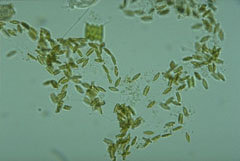 |
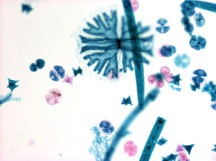 |
Filamentous forms of cyanobacteria (incorrectly
called blue-green algae) can be an especially important constituent of
the periphyton under some conditions because, unlike algae, they are able
to make use of gaseous nitrogen as a source of nutrients. Nitrogen fixation
is carried out by a specialized cell (termed a heterocyst) at the base
of each cyanobacterial filament. Cyanobacteria are an important element
of the food of some fish species but, because of their thick, gelatinous
cell coats, are not readily digested by other species. Cyanobacterial
'fixation' of atmospheric nitrogen is important because nitrogen ions
in solution can limit photosynthesis in unpolluted rivers and streams.
It also converts 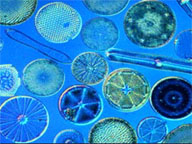 atmospheric
nitrogen into a form available to other organisms. Even where nitrogen
is available, phosphorus may limit periphyton production, and these two
nutrients are, together with illumination and flow rate, the main factors
determining the extent of periphyton development in rivers. Despite its
importance to diatoms, silica is rarely a limiting nutrient.
atmospheric
nitrogen into a form available to other organisms. Even where nitrogen
is available, phosphorus may limit periphyton production, and these two
nutrients are, together with illumination and flow rate, the main factors
determining the extent of periphyton development in rivers. Despite its
importance to diatoms, silica is rarely a limiting nutrient.
Seasonal changes in the abundance of periphyton reflect fluctuations in
river discharge. Layers of algal cells build up at times when flows are
low or declining, but are washed away during spates or flood periods in
the wet season. Suspended particles in the water scour or scrape rock
surfaces, so depleting periphyton further. Even in the dry season, some
algal cells are dislodged from the periphyton and carried downstream in
the water column. Because they remain in the water column temporarily
(until they sink to the bottom and die) they cannot be considered as 'true'
phytoplankton (i.e., free-floating algae). However, in large rivers and
backwaters, algal cells (mainly diatoms and Chlorophyta) can remain suspended
in the water column where they thrive and reproduce.
Phytoplankton
Phytoplankton is generally more abundant in lakes than rivers, and is
absent from fast-flowing streams or anywhere the rate at which the plants
are washed downstream is faster than the rate at which they reproduce.
There do not appear to be any types of phytoplankton that are confined
to running waters and, even in large rivers, 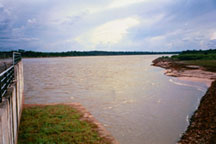 they
may not be abundant. Slow currents and areas of slack water favour the
development of phytoplankton in rivers, but if the water is turbulent
and muddy there may be insufficient light to allow photosynthesis. Nutrients
may limit phytoplankton growth also, but seem to be less important than
downstream transport or turbidity in reducing phytoplankton abundance
in rivers. Damming a river provides still-water conditions that are much
more suitable for phytoplankton, and nuisance algal 'blooms' may develop
(see Section 13.2.2). Some of them impart a foul taste to the water. Nuisance
species include cyanobacteria such as Anabaena and Microcystis,
which generally favour nutrient-rich and oxygen-poor conditions. Phytoplankton
can occur in large quantities downstream of places where water is released
from dams. In such localities, they provide food for large populations
of filter-feeding animals.
they
may not be abundant. Slow currents and areas of slack water favour the
development of phytoplankton in rivers, but if the water is turbulent
and muddy there may be insufficient light to allow photosynthesis. Nutrients
may limit phytoplankton growth also, but seem to be less important than
downstream transport or turbidity in reducing phytoplankton abundance
in rivers. Damming a river provides still-water conditions that are much
more suitable for phytoplankton, and nuisance algal 'blooms' may develop
(see Section 13.2.2). Some of them impart a foul taste to the water. Nuisance
species include cyanobacteria such as Anabaena and Microcystis,
which generally favour nutrient-rich and oxygen-poor conditions. Phytoplankton
can occur in large quantities downstream of places where water is released
from dams. In such localities, they provide food for large populations
of filter-feeding animals.
In rivers that contain significant amounts of phytoplankton, a distinct
seasonal pattern in abundance is seen. The number of algal cells per unit
volume of river water peaks during the dry season (especially the later
part) when flows are lowest. Greater flows in the wet season dilute the
concentration of suspended cells, and the rate at which they are washed
downstream increases. Elevated suspended sediment loads will increase
turbidity and reduce light and photosynthesis. Together these factors
contribute to the scarcity of phytoplankton in almost all rivers during
the wet season. Although the usual pattern is dilution and washout during
floods, the seasonal dynamics of phytoplankton can be complicated in circumstances
where floods at the beginning of the wet season wash phytoplankton from
stagnant floodplain pools or backwaters into the river mainstream causing
an increase in abundance.
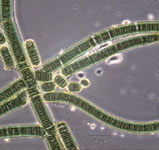 |
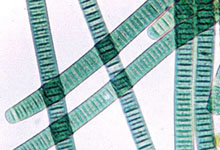 |
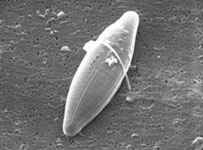 |